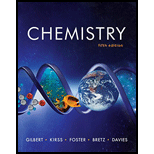
(a)
Interpretation: The strong electrolyte, the weak electrolyte, the strong acid, the weak acid and a nonelectrolyte is to be identified in the given figure.
Concept introduction: The compound which completely breaks into its constituent ions in an aqueous solution is known as an electrolyte. Ionic compounds are the examples of electrolytes.
The ions of an electrolyte carry charges with them, so when they are kept in electric field they conduct electricity.
The compound which does not break into its constituent ions in the aqueous solution is known as a nonelectrolyte. Molecular compound is the example of nonelectrolyte.
A strong acid is that which breakdowns into ions or fully protonates in the aqueous solution.
In the weak acid, there is an incomplete protonation and some molecules dissociate and others remain as a whole molecule.
To determine: If the given figure depicts a strong electrolyte, a weak electrolyte, a strong acid, a weak acid or a nonelectrolyte.
(b)
To determine: If the given figure depicts a strong electrolyte, a weak electrolyte, a strong acid, a weak acid or a nonelectrolyte.
(c)
To determine: If the given figure depicts a strong electrolyte, a weak electrolyte, a strong acid, a weak acid or a nonelectrolyte.
(d)
To determine: If the given figure depicts a strong electrolyte, a weak electrolyte, a strong acid, a weak acid or a nonelectrolyte.
Want to see the full answer?
Check out a sample textbook solution
Chapter 4 Solutions
Chemistry: The Science in Context (Fifth Edition)
 ChemistryChemistryISBN:9781305957404Author:Steven S. Zumdahl, Susan A. Zumdahl, Donald J. DeCostePublisher:Cengage Learning
ChemistryChemistryISBN:9781305957404Author:Steven S. Zumdahl, Susan A. Zumdahl, Donald J. DeCostePublisher:Cengage Learning ChemistryChemistryISBN:9781259911156Author:Raymond Chang Dr., Jason Overby ProfessorPublisher:McGraw-Hill Education
ChemistryChemistryISBN:9781259911156Author:Raymond Chang Dr., Jason Overby ProfessorPublisher:McGraw-Hill Education Principles of Instrumental AnalysisChemistryISBN:9781305577213Author:Douglas A. Skoog, F. James Holler, Stanley R. CrouchPublisher:Cengage Learning
Principles of Instrumental AnalysisChemistryISBN:9781305577213Author:Douglas A. Skoog, F. James Holler, Stanley R. CrouchPublisher:Cengage Learning Organic ChemistryChemistryISBN:9780078021558Author:Janice Gorzynski Smith Dr.Publisher:McGraw-Hill Education
Organic ChemistryChemistryISBN:9780078021558Author:Janice Gorzynski Smith Dr.Publisher:McGraw-Hill Education Chemistry: Principles and ReactionsChemistryISBN:9781305079373Author:William L. Masterton, Cecile N. HurleyPublisher:Cengage Learning
Chemistry: Principles and ReactionsChemistryISBN:9781305079373Author:William L. Masterton, Cecile N. HurleyPublisher:Cengage Learning Elementary Principles of Chemical Processes, Bind...ChemistryISBN:9781118431221Author:Richard M. Felder, Ronald W. Rousseau, Lisa G. BullardPublisher:WILEY
Elementary Principles of Chemical Processes, Bind...ChemistryISBN:9781118431221Author:Richard M. Felder, Ronald W. Rousseau, Lisa G. BullardPublisher:WILEY





